“It’s like giving children up for adoption”- Shigeaki Asahara on his lamps
Interview
Shigeaki Asahara, probably most known for the designs he did for Stilnovo, divides his time between Japan and Italy, where he lives with his family. As a young man his fascination for Italian car design brought him from Japan to Turin.
-
Shigeaki Asahara: “It all started with my teacher Nakamoto Tatsuya, an artist of whom I was very fond. He taught painting in Kunitachi, my city, and as a boy I used to attend his lessons diligently. Kunitachi is home to important universities and housed artists of great interest. My teacher had been to Italy and had lived in Turin for a year and a half. He always spoke to me about this city with great enthusiasm.
He encouraged me to visit, and I registered at the Accademia Albertina di Belle Arti di Torino (Albertina Academy of Fine Arts in Turin-Palainco). There were many compelling cultural meet-ups; the atmosphere was highly stimulating. Initially, I dedicated myself to painting. One of my paintings was selected at the contest Arte Giovane (Young Art) exhibition in Turin!”
-
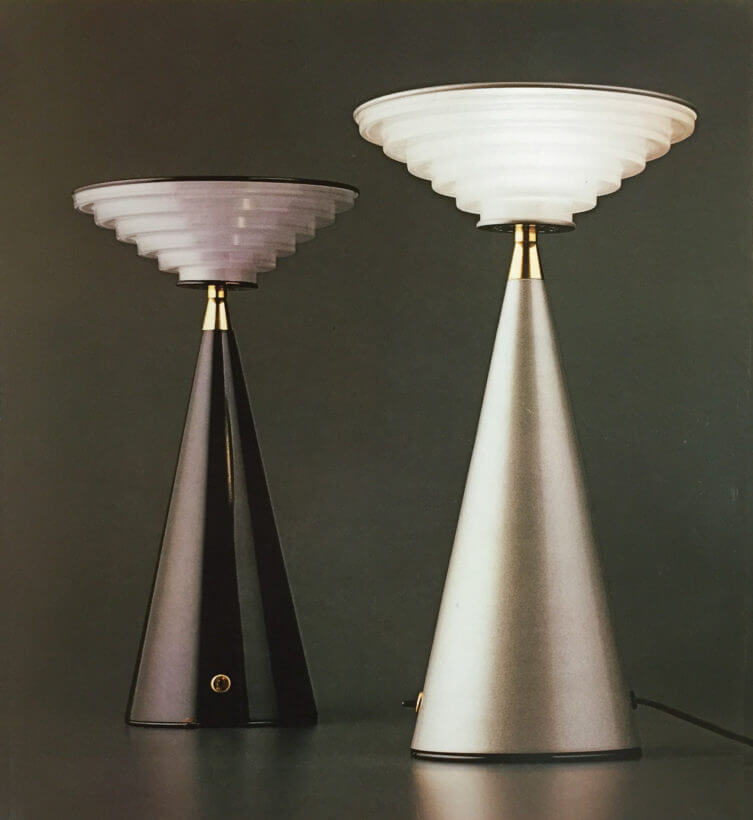 Ziggurat table lamp by Shigeaki Asahara for Stilnovo as presented in Stilnovo catalogue No. 55 (from the Palainco archive).
Main picture: Shigeaki Asahara (from Shigeaki Asahara's personal collection).
Ziggurat table lamp by Shigeaki Asahara for Stilnovo as presented in Stilnovo catalogue No. 55 (from the Palainco archive).
Main picture: Shigeaki Asahara (from Shigeaki Asahara's personal collection).
-
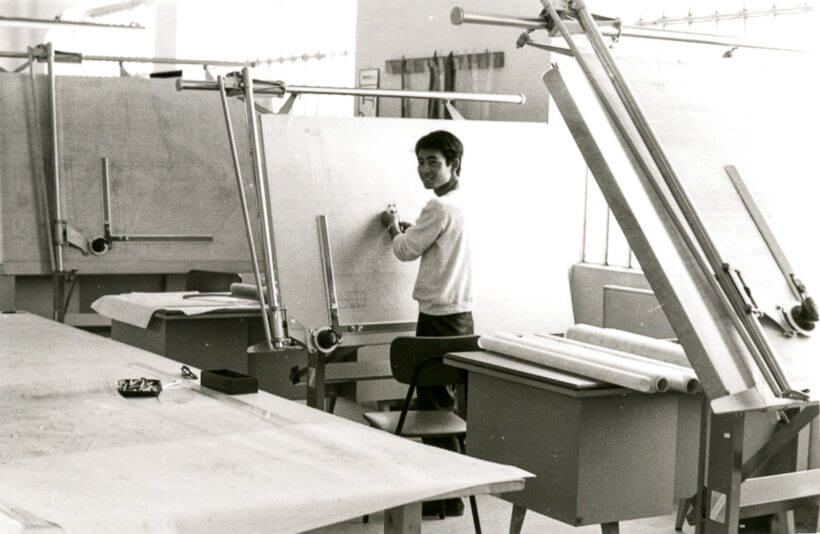 Shigeaki Asahara in the early 1970s (From Shigeaki Asahara's personal collection).
Shigeaki Asahara in the early 1970s (From Shigeaki Asahara's personal collection).
-
“My first stay in Turin was very useful, as it gave me the opportunity to meet people who worked in the world of coachbuilders, like Mr. Myakawa, who worked in the automobile sector for Japan.
Later I returned to Japan, where I worked for the company Adam&Eve, gaining experience in the field of ceramics. It was a very creative period for me.
When I was back in Turin, Studio ABACO, a famous architecture and interior design studio was looking for a young designer. I started collaborating with them, which turned out to be a positive and highly creative experience.”
-
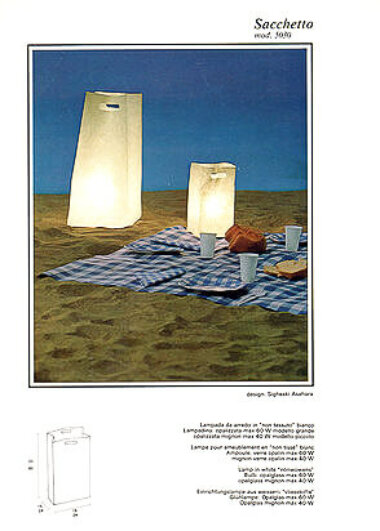 Model Sacchetto by Shigeaki Asahara for Cristal Art (picture from Shigeaki Asahara's personal collection).
Model Sacchetto by Shigeaki Asahara for Cristal Art (picture from Shigeaki Asahara's personal collection).
-
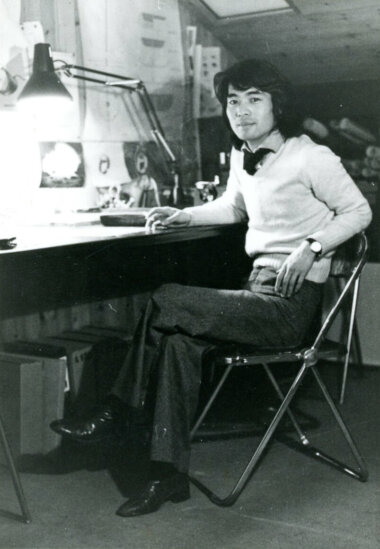 Shigeaki Asahara at Studio ABACO in Turin (from Shigeaki Asahara's personal collection).
Shigeaki Asahara at Studio ABACO in Turin (from Shigeaki Asahara's personal collection).
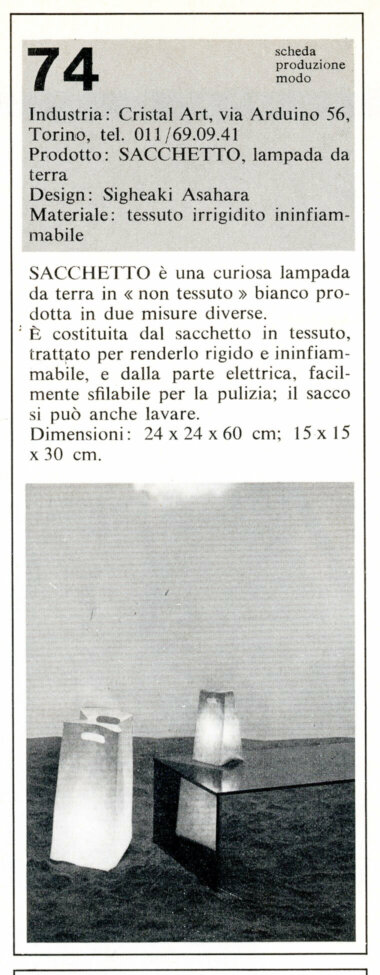 Model Sacchetto in MODO magazine, June 1978 (from Shigeaki Asahara's personal collection).
Model Sacchetto in MODO magazine, June 1978 (from Shigeaki Asahara's personal collection).
-
“While working at Studio ABACO, in 1977 or 1978, I designed the Sacchetto lamp for Cristal Art in Turin. It was practically my first project, a simple but interesting idea and also fun: it could be folded like a real bag and it gave soft light.”
An advertisement for the Sacchetto lamp describes the model as follows (see picture above): “Sacchetto is a curious white ‘non-woven’ floor lamp, produced in two different sizes. It consists of a fabric bag, treated to make it rigid and non-flammable, and the electric part, which can be easily removed for cleaning; it is washable.”
After the period at Studio ABACO Asahara continued to work as a freelance designer. In 1980 the table lamp Tokio that was produced by Stilnovo, was selected for the Compasso d’Oro, the most prestigious design award in Italy. The Tokio lamp is also part of the permanent collection of the Brooklyn Museum.
-
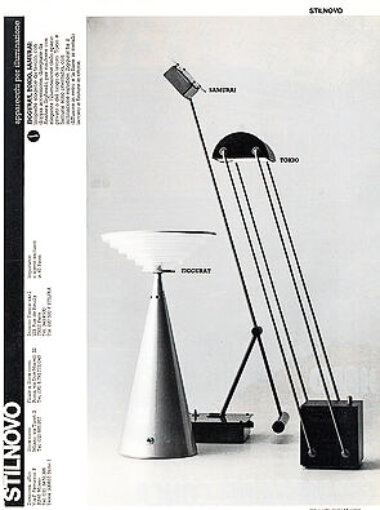 Ziggurat, Samurai and Tokio table lamps as presented in an advertisement for Stilnovo from the 1980s (from the Palainco archive).
Ziggurat, Samurai and Tokio table lamps as presented in an advertisement for Stilnovo from the 1980s (from the Palainco archive).
Shigeaki Asahara: “I wanted to design a lamp that could be tilted without having to always adjust the head: I found the solutions that were available very uncomfortable, and in this way the structure moved in a parallel direction.
I contacted Stilnovo directly and presented a 1:1 scale model of the lamp. It was immediately accepted and we proceeded with the construction of the prototype. The initial design was much thinner and more elegant, but the problem was that it got too hot, because of the halogen lamp and the small size of the head. In the end the transformer gave the lamp a more impactful appearance.”
-
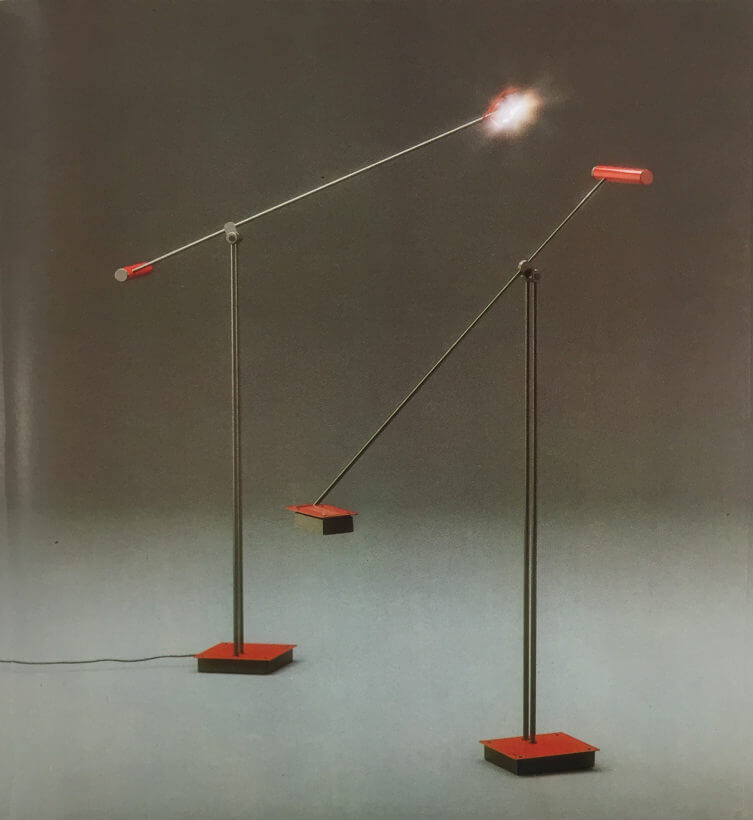 Samurai floor lamps by Shigeaki Asahara in Stilnovo Catalogue No. 55 (from the Palainco archive).
Samurai floor lamps by Shigeaki Asahara in Stilnovo Catalogue No. 55 (from the Palainco archive).
-
“For the Samurai series that was produced in the 1980s I had also made a model. Initially the head was curved and not flat, but as it was considered too similar to Tokio, so a square shape was chosen. The particularity of this lamp lies in the fact that to balance it the dimmer and the switch are positioned in the weight.
The names of my lamps do not really matter to me; I never baptised my designs, the names have always been chosen by the companies. I’m happy that my designs are appreciated and I would rather be able to see how people use them in their homes. In a way it’s a bit like giving children up for adoption!
Accidentally I found a picture of Tadao Ando in his studio in an architecture magazine, with my lamp on his desk. I was very happy to see that!”
-
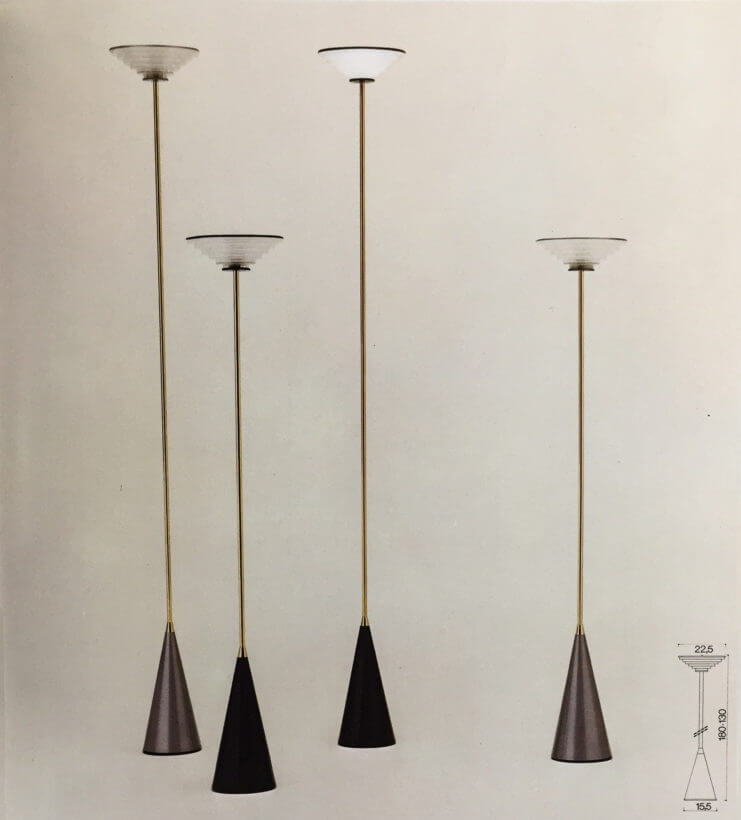 Ziggurat floor lamps by Shigeaki Asahara in Stilnovo catalogue No. 55 (from the Palainco archive).
Ziggurat floor lamps by Shigeaki Asahara in Stilnovo catalogue No. 55 (from the Palainco archive).
-
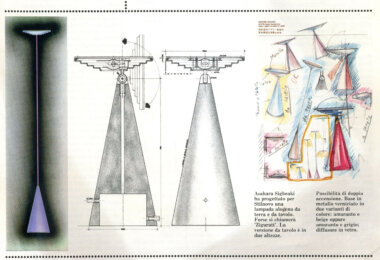 Sketches and technical drawings for series table, floor and wall lamps Ziggurat for Stilnovo (from Shigeaki Asahara's personal collection).
Sketches and technical drawings for series table, floor and wall lamps Ziggurat for Stilnovo (from Shigeaki Asahara's personal collection).
-
“The concept of Ziggurat did not have any specific inspiration. An idea can come out of nothing, or come to life slowly, working on models that need to be modified until you obtain the optimal result. Fundamentally, like all creative works, design is a union of imagination, experience, chance and observation.”
-
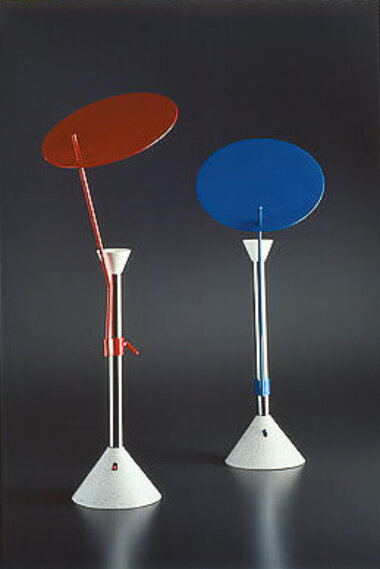 Luna table lamp by Shigeaki Asahara for Stilnovo (picture from Shigeaki Asahara's personal collection).
Luna table lamp by Shigeaki Asahara for Stilnovo (picture from Shigeaki Asahara's personal collection).
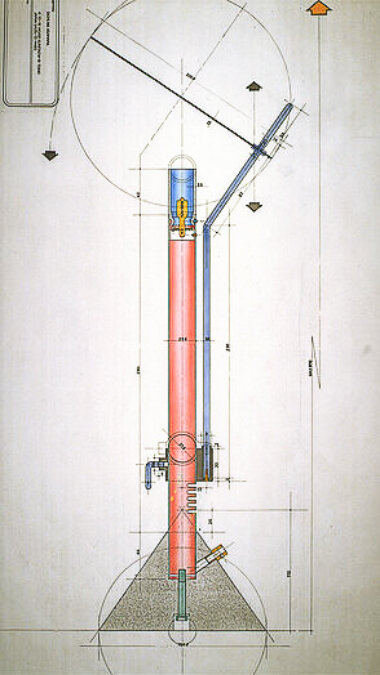 Techical drawing for Luna table lamp by Shigeaki Asahara for Stilnovo (picture from Shigeaki Asahara's personal collection).
Techical drawing for Luna table lamp by Shigeaki Asahara for Stilnovo (picture from Shigeaki Asahara's personal collection).
-
“When I designed Luna I think that I was influenced by the art movement Memphis, which at that time was a completely creative explosion. I often opted for the colour of sand, characteristic for those years. It was really an effervescent period. The plate of Luna acts as a reflector and is simultaneously an aesthetic and technical element.”
-
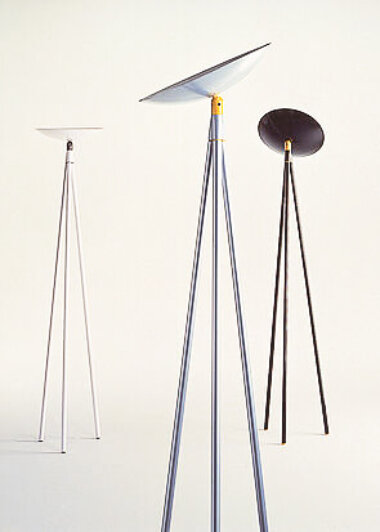 Palomar floor lamp by Shigeaki Asahara for Stilnovo (picture from Shigeaki Asahara's personal collection).
Palomar floor lamp by Shigeaki Asahara for Stilnovo (picture from Shigeaki Asahara's personal collection).
“Palomar is completely different from Luna, the technical and aesthetic principles do not cross. Palomar is a parabola with a reflector placed internally, so aesthetic and technical elements are separate.
The first prototype of the Palomar had a very small parabola, but it didn’t convince me. During a meeting we decided to give it a very large parabola, from which her name was derived. This happened only a few days before the Salone del Mobile!”
-
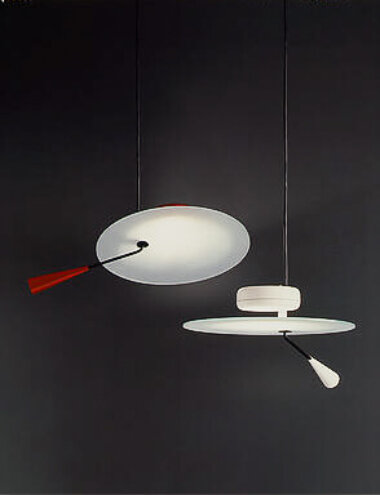 Bascula pendant by Shigeaki Asahara for Stilnovo (picture from Shigeaki Asahara's personal collection).
Bascula pendant by Shigeaki Asahara for Stilnovo (picture from Shigeaki Asahara's personal collection).
When Asahara began working in Turin in the 1970s, the world of design was very different from now. Obviously, current techniques were not available at the time, but above all personal contacts were more spontaneous.
Shigeaki Asahara: “At the time, obviously, there was no 3D printing, contacts were made with “real” people and everything was done manually, even in the automotive sector.
With my tools I would make scale models based on sketches and drawings, only the real object would often not emerge clearly. The times were longer and we relied on human contact. Nowadays the models are made with the 3D printer, the procedure is speeded up and contacts are made on the internet…
With Stilnovo for example, our contact was direct and personal: I took the projects directly to the head office, submitting them as a proposal.” -
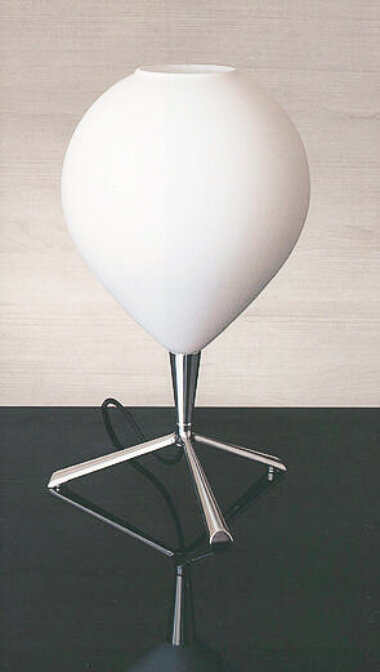 Olla table lamp by Shigeaki Asahara for Lucitalia (picture by Lucitalia).
Olla table lamp by Shigeaki Asahara for Lucitalia (picture by Lucitalia).
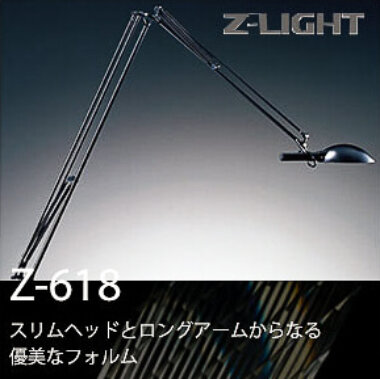 Z-618 desk lamp by Shigeaki Asahara for Yamada (picture from Shigeaki Asahara's personal collection).
Z-618 desk lamp by Shigeaki Asahara for Yamada (picture from Shigeaki Asahara's personal collection).
-
“In the 1990s I started collaborating with Lucitalia. Olla was an interesting lamp because of the difficulty involved. It had to be competitive and not resemble the lamps on the market at that time. It was a challenge to create something original and different, as the competition was huge and fierce.
In Italy, in the 1980s, I also worked for Candle and Contact. Contact did not use moulds, and it was difficult to design pieces that could only be turned or bent. In this period I also worked in Japan for Yamada, then in the 1990s for Ushio and in the 2000s for Daiko. With Daiko in the 2000s I dedicated myself to technical lamps, instead of decorative lamps for interior design. My projects in Japan were produced for the Japanese market only.
From what I designed for Yamada in the 1980s, I think the most interesting was the Z618 desk lamp, with a very extended arm. In the 1990s I collaborated with car designer Marcello Gandini on a series of spotlights for Yamada.”
-
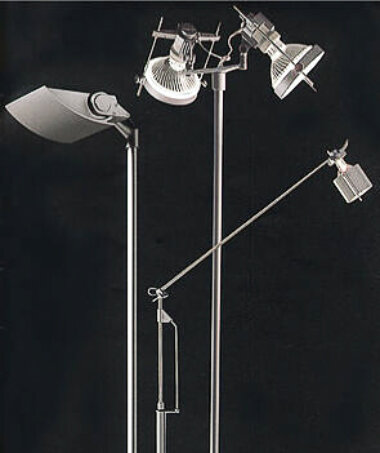 Karma (left) and Kri floor lamps for Lucitalia (picture from Shigeaki Asahara's personal collection).
Karma (left) and Kri floor lamps for Lucitalia (picture from Shigeaki Asahara's personal collection).
“My personal style is easily recognisable, for me it is gratifying.
It is difficult for me to describe it. I think it is a spontaneous path that every professional goes through, putting passion, commitment and consistency in what he does.My favourite designs are definitely Spotlight Corso, designed for Daiko; Karma floor lamp for Lucitalia; and of course Tokio, mainly for emotional reasons.
I see much of myself in these lamps. I would add the Kri for Lucitalia, because they express a concept of intelligence, not in structure or movement, but in form. Kri is not affected by fashions, it is always current; a beautiful series of wall spotlights.” -
Looking back on his career, it seems remarkable that Asahara ended up designing mostly lights.
Shigeaki Asahara: “Designing for the automotive industry proved to be complicated, there was too much competition and the considerable dimensions were an obstacle to me physically. The main problem was the industrialisation of both the design process and the manufacturing process in the automotive field was changing. The artisan part was getting lost, and the big houses no longer relied on small body shops, but on established designers and technicians inside the parent company. With lighting I could work without co-operators, in all tranquillity, which is more suited to my character.
I have always been involved in product design; I felt that it was the sector that most suited my taste. By designing small objects I can easily imagine how they will turn out eventually. Besides, one can almost think of a lamp as a sculpture with practical use.”
Through the years Asahara received international recognition for his work. In Japan he twice received the award for Good Design from the Ministry of Industry. In Italy, table lamp Tokio was selected for the Compasso d’Oro. His designs can be found in important museums in New York and Tokyo. Furthermore, Asahara’s models Tokio, Luna and Palomar are mentioned in the standard work on Italian design, ‘Repertorio del Design Italiano 1950-2000′ by Giuliana Gramigna. He is one of the few foreign designers listed.
“I don’t think nationality matters; if an object is beautiful and valid, it works without anything else. My projects are the result of exchanges of ideas, of discussions; in all creative sectors contacts are very important, whatever the cultural backgrounds.
I am happy with the awards I received, for me it was very rewarding to receive the IF Design Award in Hannover and the Best Category of 1992 for Spotlight Yamada. Over the years I have received both the IF award in Germany and the Good Design award in Japan many times. But surely the greatest gratification is when my designs chosen for homes are being used daily.
Although I have slowed down my activity, I still work. As always in the lighting sector, especially in the field of professional spotlights, in which I recognise myself most in recent years.
Many designs were never realised, often due to space problems for the power supply, or because of heat. Today it would be possible to improve them. My drawers might hide interesting ideas, who knows …”
If you would like to be the first to read articles on designers and special designs, please subscribe to our newsletter.
-
- Palainco wishes to thank: Shigeaki Asahara, Andrea Asahara and Anna Curti.
Unless otherwise stated, all material is sourced and/or generated internally. All rights reserved.
- Text: Palainco, Koos Logger & Ingrid Stadler.
- Image sources: Shigeaki Asahara and Palainco.
The article and its contents may not be copied or reproduced in any part or form without the prior written permission of the copyright holders.
Published on: 25 April 2019